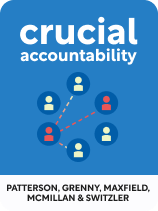

This article is an excerpt from the Shortform book guide to "Crucial Accountability" by Kerry Patterson, Joseph Grenny, et al.. Shortform has the world's best summaries and analyses of books you should be reading.
Like this article? Sign up for a free trial here .
What is the meaning of crucial accountability? How does accountability improve relationships?
Crucial Accountability is a book written by communication and management experts. It explores how an accountability discussion can save a relationship when someone has behaved in a way that is hurtful or disappointing.
Keep reading for more about Crucial Accountability and the ability to solve problems by holding others accountable.
Crucial Accountability
Accountability conversations are the discussions we have when someone breaks a promise, violates a commitment, behaves badly, or fails to meet our expectations. These conversations are important because, without them, our relationship with the other person could end up permanently damaged. Unfortunately, people tend to handle these conversations incorrectly—or not have them at all. In Crucial Accountability, communication and management experts Kerry Patterson, Joseph Grenny, David Maxfield, Ron McMillan, and Al Switzler explain how we can effectively have these conversations to solve the issues at hand while preserving our relationship with the other person.
Why Accountability Conversations Are Crucial
Holding others accountable is a crucial skill because if we handle our issues incorrectly or not at all, we may experience negative consequences. If we neglect the issue and remain silent, we could permanently damage our relationship with the other person by developing toxic communication and passive-aggressive behaviors. If we bring up the issue and handle it improperly, we could risk offending the other person, thereby damaging our relationship and reputation with them. In either case, if we fail to bring up the issue or do so incorrectly, we allow the issue to continue and possibly get worse.
(Shortform note: In 12 Rules of Life, psychologist Jordan Peterson corroborates the authors’ argument that you must plan a crucial discussion to effectively execute it. He explains that if we communicate our interpersonal conflicts without planning ahead, we risk inciting emotional reactions from the other person such as resentment, jealousy, frustration, and even hatred. Like the authors of Crucial Accountability, Peterson notes that if we ignore an issue because we fear these emotional reactions, we may end up creating more negative consequences, such as building up negative emotions and allowing the issue to persist. Either way, these outcomes will damage our relationship with the other person.)
Consequently, the authors wrote Crucial Accountability to help bosses, employees, parents, friends, and others effectively handle these conversations. They have written several best-selling books on communication, performance, and leadership skills and have created a leadership training company, Crucial Learning, that offers supplemental courses. Overall, they refer to these fundamentals as “crucial skills.” Crucial Accountability hones in on one of these crucial skills—holding others accountable.
Crucial Accountability is a step-by-step guide that teaches us how to properly prepare for, execute, and follow up on our accountability conversations. As an added bonus, the authors discuss a few exceptional situations that may require a slightly different approach from the steps in their guide, and advise us on how to handle these situations.
Preparing for the Discussion
The authors explain that to prepare for your discussion, you first need to identify the key issue at the root of the accountability grievance and then determine whether or not you should discuss it. You also need to avoid making assumptions by trying to see the issue from the other person’s perspective.
Identify the Key Issue
The first step to an accountability conversation is identifying the key issue and then determining whether or not it’s worth bringing up. The authors explain that accountability grievances usually come in bundles; instead of just one problem, there are often a whole host of issues that make up the grievance. However, there is usually one key issue at the root of the grievance—the underlying problem causing all the other issues. When the key issue is identified and solved, the other issues will likely be resolved as well.
If we don’t pinpoint the underlying problem, we could end up addressing the wrong issue or addressing too many issues at once, neither of which will solve the problem.
Determine Whether or Not to Address the Issue
The second step is deciding whether the issue is worth bringing up. The authors explain that sometimes, the issue we’re upset about doesn’t warrant an accountability conversation. They explain that the purpose of holding an accountability conversation should be to maintain a positive and productive relationship with the other person. If your intent for the conversation doesn’t match this definition or having the discussion won’t achieve this goal, you should probably cope or get over the issue rather than bring it up. For example, if you want to have an accountability conversation because your adult daughter dyed her hair, this probably isn’t a valid issue—your intent for the discussion isn’t to improve your relationship or its productivity—rather, it’s to impose your worldview on her. And, the consequences of the discussion will neither improve your relationship nor resolve the problem—instead, it will probably make both of them worse.
Executing the Accountability Conversation
The authors then move from preparing for the conversation to having the conversation.
To effectively execute our discussion, we need to bring up the issue in a way that makes the other person feel safe, work with them to identify barriers and solutions, handle any new issues that arise during the conversation, and be aware of behaviors to avoid.
Establishing Mutual Respect and Shared Purpose
The fourth step is addressing the issue in a way that establishes mutual respect and a shared purpose with the other person. In other words, vocalize the issue while letting the other person know through your words, tone, and body language that you respect them and want to improve your relationship—which will benefit both parties.
To do this, explain the issue succinctly: Express your expectations and how the other person failed to meet them. Then, invite them to respond. Throughout the conversation, watch for signs that the other person is feeling unsafe and re-establish safety when necessary (either by clarifying your respect or shared purpose).
(Shortform note: If you fail to establish mutual respect, a shared purpose, or explain the issue succinctly, the other person is likely to feel overwhelmed and stifled. The most common reaction to these negative emotions is to stonewall—to tune the speaker out by ignoring them, acting busy, turning away, or engaging in obsessive behaviors. Stonewalling could permanently damage or end a relationship. You can avoid this consequence by following the authors’ suggestions: Be succinct, be respectful, and establish a mutual purpose.)
Following Up
With the details of how to initiate and execute the conversation down, the last step is to effectively follow up on our chosen solution.
First, we need to explain to the other person what needs to get done by identifying specifically who does what by when. Don’t leave any of these tactics up for interpretation or you may be disappointed with the results.
(Shortform note: Experts second the authors’ argument here, explaining that the three things necessary for an employee to effectively complete a task are clear goals, detailed parameters, and accurate deadlines. No matter how self-sufficient, responsible, or hard-working someone is, they can’t effectively meet expectations without certain structures and boundaries.)
Next, we need to determine the intensity, frequency, and type of follow-up. How soon and often will you check on results? Who will initiate the check-in? Does it need to be during a private meeting or a routine interaction? The authors explain that there are a few factors to consider when making these decisions: how reliable the person is, how experienced they are in the area, how difficult the task is, and how crucial the task is

———End of Preview———
Like what you just read? Read the rest of the world's best book summary and analysis of Kerry Patterson, Joseph Grenny, et al.'s "Crucial Accountability" at Shortform .
Here's what you'll find in our full Crucial Accountability summary :
- How to broach sensitive conversations with loved ones and coworkers
- How to prepare for, execute, and follow up on accountability conversations
- How to solve issues while improving your relationships






